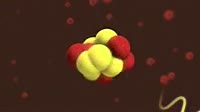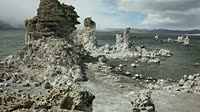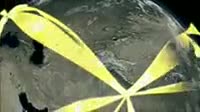Animation of the CNO cycle, a series of nuclear reactions that provides most of the energy in massive stars. The cycle converts four hydrogen nuclei (protons, red) into a helium nucleus, with a release of energy. It is a catalytic cycle, named as the nuclear reactions cycle through isotopes of carbon, nitrogen and oxygen. Initially, a free proton fuses with a carbon-12 nucleus, forming nitrogen-13 and emitting a gamma ray (yellow wave). This undergoes beta decay, in which a proton is converted to a neutron (yellow) with the emission of a positron (orange) and a neutrino (pink), forming carbon-13. Another proton then fuses, forming nitrogen-14 and a gamma ray, followed by a third proton, forming oxygen-15 and another gamma ray. This undergoes beta decay to nitrogen-15, emitting a positron and neutrino, before the fusion of a fourth proton ejects an alpha particle (helium-4), reforming the carbon-12. The process repeats in an endless cycle, converting hydrogen to helium and emitting energy. The CNO cycle is the dominant energy source for stars more than 1.3 times the Sun's mass. In Sun-sized stars, the proton-proton chain dominates: just 0.8% of the Sun's energy is produced by this cycle. For the proton-proton chain powering the Sun, see clip K003/3971.
Details
WebID:
C00724649
Clip Type:
RM
Super High Res Size:
1920X1080
Duration:
00:00:17.000
Format:
QuickTime
Bit Rate:
25 fps
Available:
download
Comp:
200X112 (0.00 M)
Model Release:
NO
Property Release
No













 Loading
Loading